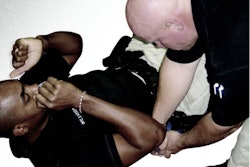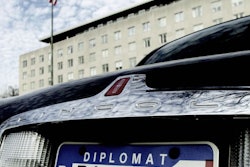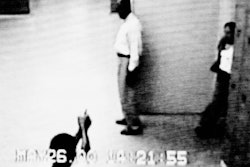A criminal suspect has a Fifth Amendment right not to be compelled to incriminate himself, so he cannot be forced to make a statement. But if he is lawfully in custody, he can be compelled to submit to particular tests or to provide exemplars of his physical attributes. Under some circumstances, he can also be compelled to behave in certain ways ("modeling") in order to assist in identification.
Modeling, testing, and exemplars can be obtained by voluntary compliance with police requests, or in response to a grand jury subpoena, or by court order. If the suspect refuses, the prosecution is generally free to argue to the jury that the refusal constitutes consciousness of guilt.
Tests and Exemplars
In Schmerber v. California, 384 US 757 (1966), the U.S. Supreme Court upheld the extraction of blood from a suspect who was lawfully arrested for driving under the influence. Since no statement was compelled, the Fifth Amendment was not violated.
Applying this analysis, the Supreme Court and federal appellate courts have upheld requirements that suspects submit to various tests or provide particular exemplars:
• Gilbert v. California, 388 US263 (1967). Handwriting exemplars can be taken from a robbery suspect, for comparison with the handwritten demand note the perpetrator delivered to the victim.
• U.S. v. Dionisio, 410 US 1 (1973). Voice exemplars were properly ordered to be recorded to enable grand jurors to compare suspects' voices with those on recordings of gambling suspects during wagering.
• U.S. v. Wade, 388 US 218 (1967). Suspect could be compelled to repeat the words used by the robber, to allow the witness to compare his voice.
• Burnett v. Collins, 982 F.2d 922 (5th Cir. 1993). During trial in a Texas case, it was permissible to require the defendant to repeat the threats and vulgarities used during the robbery, to permit the witness to give an opinion that the voice was the same.
• U.S. v. Delaplane, 778 F.2d 570 (10th Cir. 1985). Recordings of wiretapped conversations were played to the Colorado jury, and the defendant was then compelled to read from a transcript of the wiretap tapes, to allow the jury to compare voices.
• Pennsylvania v. Muniz, 496 US 582 (1990). Arresting officer made a video and audio recording of DWI suspect's field sobriety tests to illustrate the suspect's slurred speech and poor coordination. The Supreme Court ruled this evidence admissible to help establish the suspect's intoxication.
• Kyger v. Carlton, 146 F.3d 374 (6th Cir. 1998). Upholding a Tennessee murder conviction, the federal appeals court ruled that both fingerprinting and swabbing for a gunshot-residue test were within the Schmerber rule.
• U.S. v. Dougall, 919 F.2d 932 (5th Cir. 1990). Police threat to seek a court order was permissible to obtain a rape suspect's compliance with a request for a hair sample.
• Belgarde v. State of Montana, 123 F.3d 1210 (9th Cir. 1997). Where there was probable cause to arrest a DUI suspect who was hospitalized and unconscious, it was constitutional to extract a blood sample in a medically approved manner.
• U.S. v. Edmo, 140 F.3d 1289 (9th Cir. 1998). The Schmerber rule permitted police to compel a suspect to provide a urine specimen, where he was lawfully arrested for being in possession of a firearm while under the influence of a controlled substance.
• U.S. v. Maceo, 873 F.2d 1 (1st Cir. 1989). An officer's forcible examination of the teeth and gums of a Rhode Island suspect in a cocaine distribution case to confirm his identity did not violate the suspect's rights.
• Shaffer v. Saffle, 148 F.3d 1180 (10th Cir. 1998). Correctional officers could require a convicted murderer to submit to DNA testing, under an Oklahoma statute mandating DNA samples from certain convicted criminals.
Courts have approved requests or orders for the following from lawfully arrested suspects:
- Handwriting exemplars
- Voice exemplars
- Repeating robber's words
- Reading wiretap transcripts
- Taped field sobriety tests
- Fingerprinting
- Swabbing for GSR test
- Hair sample
- Blood sample
- Urine sample
- DNA sample
- Teeth and gum exam
Modeling Conduct
Sometimes the suspect's clothing or physical appearance has changed between the time of the crime and the time when a witness is asked to try to make an ID. Re-creating the conditions of the original view may require the suspect to try on clothing, make cosmetic changes, or act in a certain way.
Nearly a century ago, the Supreme Court ruled that the Fifth Amendment was not violated by compelling a suspect to try on a shirt that was known to belong to the perpetrator, to see if it fit. Holt v. US, 218 US 245 (1910).
The federal appeals courts have applied the Holt rule in various ways:
• U.S. v. Montgomery, 100 F.3d 1404 (8th Cir. 1996). When Missouri officers found two suspects in possession of 996 grams of cocaine wrapped in two shirts, it was permissible to require the suspects to try on the shirts for fit.
• U.S. v. Bullard, 37 F.3d 765 (1st Cir. 1994). A Boston bank robbery suspect had no right to refuse a police request that he put on his baseball cap, similar to the one worn by the robber in surveillance photos.
• Engberg v. Wyoming, 265 F.3d 1109 (10th Cir. 2001). Prosecutor was permitted to introduce evidence of the defendant's refusal to be photographed for ID in an orange stocking cap found in his car, matching the description of the cap worn by the murderer.
• U.S. v. Roberts, 481 F.2d 892 (5th Cir. 1973). The Holt rule allowed the trial judge to order the defendant to put on a mask, so the witness could compare his appearance to that of the masked robber.
• U.S. v. Valenzuela, 722 F.2d 1431 (9th Cir. 1983). A California robbery suspect who grew a beard and a mustache between arrest and trial could be ordered to shave for ID.
• U.S. v. Hammond, 419 F.2d 166 (4th Cir. 1969). A Maryland robbery suspect who had shaved his goatee between the crime and the date of the lineup was properly ordered to appear in the lineup wearing a false goatee.
• U.S. v. Murray, 523 F.2d 489 (8th Cir. 1975). A Missouri robbery suspect could be compelled to wear a wig during ID, as the robber had worn in surveillance photos.
• U.S. v. Brown, 920 F.2d 1212 (5th Cir. 1991). Louisiana bank robber who had allowed his dyed hair to grow out to its natural gray condition during seven months between crime and trial was lawfully required to dye his hair to the same color it had been during the robbery, to enable the witness to ID him.
• Avery v. Procunier, 750 F.2d 444 (5th Cir. 1985). Taking the suspect to the scene and forcing him to re-enact the robbery in the witness's presence did not violate the Fifth Amendment privilege against compelled self-incrimination.
Courts have upheld cases compelling suspects to do the following:
- Wear certain clothing
- Wear a mask
- Shave
- Wear false whiskers
- Wear a wig
- Dye hair
- Re-enact the crime
Note: As always, consult local advisors for restrictions in your jurisdiction.
Devallis Rutledge, a former police officer and veteran prosecutor, is Special Counsel to the Los Angeles County District Attorney.


















